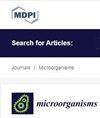Differential Expression Analysis Reveals Possible New Quaternary Ammonium Compound Resistance Gene in Highly Resistant Serratia sp. HRI
IF 4.1
2区 生物学
Q2 MICROBIOLOGY
引用次数: 0
Abstract
During the COVID-19 pandemic, the surge in disinfectant use emphasised their pivotal role in infection control. While the majority of antimicrobial resistance research focuses on antibiotics, resistance to biocides, which are present in disinfectants and sanitisers, is escalating. Serratia sp. HRI is a highly resistant isolate, and through the study of this organism, the molecular mechanisms of resistance may be uncovered. Serratia sp. HRI was treated with the disinfectant benzalkonium chloride in preparation for RNA sequencing. Through mining of the RNA-Seq differential expression data, an uncharacterised Major Facilitator Superfamily (MFS) efflux pump gene was found to be up-regulated at least four-fold at four different time points of exposure. Real-time PCR revealed this uncharacterised MFS efflux gene was up-regulated after exposure to benzalkonium chloride and two additional disinfectants, didecyldimethylammonium chloride (DDAC) and VirukillTM. Additionally, expression of this gene was found to be higher at 20 min versus 90 min of exposure, indicating that the up-regulation of this gene is an initial response to biocide treatment that decreases over time. This suggests that MFS efflux pumps may be an initial survival mechanism for microorganisms, allowing time for longer-term resistance mechanisms. This work puts forward a novel biocide resistance gene that could have a major impact on biocide susceptibility and resistance.差异表达分析揭示高抗性沙雷氏菌 HRI 中可能存在新的季铵化合物抗性基因
在 COVID-19 大流行期间,消毒剂使用量的激增凸显了消毒剂在感染控制中的关键作用。虽然大多数抗菌药耐药性研究都集中在抗生素上,但对消毒剂和卫生消毒剂中的杀菌剂的耐药性却在不断升级。HRI 沙雷氏菌是一种高度耐药的分离菌,通过对这种生物的研究,可能会发现耐药性的分子机制。HRI 沙雷氏菌用消毒剂苯扎氯铵处理,准备进行 RNA 测序。通过挖掘 RNA-Seq 差异表达数据,发现在四个不同的暴露时间点,一个未表征的主要促进剂超家族(MFS)外排泵基因至少上调了四倍。实时聚合酶链式反应(Real-time PCR)显示,在接触苯扎氯铵和另外两种消毒剂(二癸基二甲基氯化铵(DDAC)和VirukillTM)后,这种未表征的MFS外排基因上调。此外,还发现该基因在接触 20 分钟和 90 分钟时的表达量更高,这表明该基因的上调是对杀菌剂处理的初始反应,随着时间的推移会逐渐降低。这表明 MFS 外排泵可能是微生物最初的生存机制,从而为长期的抗性机制留出了时间。这项研究提出了一种新型杀菌剂抗性基因,它可能对杀菌剂的易感性和抗性产生重大影响。
本文章由计算机程序翻译,如有差异,请以英文原文为准。
求助全文
约1分钟内获得全文
求助全文
来源期刊

Microorganisms
Medicine-Microbiology (medical)
CiteScore
7.40
自引率
6.70%
发文量
2168
审稿时长
20.03 days
期刊介绍:
Microorganisms (ISSN 2076-2607) is an international, peer-reviewed open access journal which provides an advanced forum for studies related to prokaryotic and eukaryotic microorganisms, viruses and prions. It publishes reviews, research papers and communications. Our aim is to encourage scientists to publish their experimental and theoretical results in as much detail as possible. There is no restriction on the length of the papers. The full experimental details must be provided so that the results can be reproduced. Electronic files and software regarding the full details of the calculation or experimental procedure, if unable to be published in a normal way, can be deposited as supplementary electronic material.
文献相关原料
| 公司名称 | 产品信息 | 采购帮参考价格 |
|---|
 求助内容:
求助内容: 应助结果提醒方式:
应助结果提醒方式:


